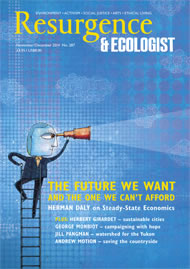Round about 8.30 on a summer evening way back in August 1992, the police in Finsbury Park, North London started getting phone calls. The tower blocks in the local estate were swaying. Windows were cracking, balconies coming loose. Panic spread among the residents evacuated onto the street. There’s an earthquake in Finsbury Park. Then the police got a phone call from a local resident. Maybe, she told them, it isn’t an earthquake. There’s a Madness concert in the Park. What had happened? It was Madstock, Madness’s reunion gig, and at the opening bars of One Step Beyond, 80,000 fans started dancing to the beat. The vibrations, amplified by an underground lake, carried all the way to the foundations of the eight-storey blocks, and the towers started dancing. The concrete began to skank.
A moment of connection in North London, an earthquake born out of what the historian Eric Hobsbawm called “the ecstasy of others”. But 25 years later the Los Angeles Times gave a hint of a subtly different earthquake building up, one that could have the opposite effect.
At 6.25am on 17 March this year, Ken Schwencke, a journalist at the Los Angeles Times, emailed to his editors a brief story on the latest tremor to hit the region. “A shallow magnitude 4.7 earthquake was reported Monday morning… According to the USGS [the US Geological Survey], the epicentre was six miles from Beverly Hills, California...” But the real earthquake was not in the story. It was in the byline: “This post was created by an algorithm written by the author.” Quakebot, the program Schwenke developed, plugs alerts from the USGS into a template, then sends it to the LA Times editors for review. Schwenke’s input into his report that morning was estimated at three seconds’ worth.
What’s the point? In September 2013 the Oxford Martin School released a report that predicted that, with the advance of big data, 47% of US professional-class white-collar jobs were at “high risk” of being replaced by automation. It was not just physical tasks, routine and non-routine, that could be “off-peopled”: it was now tasks involving cognition. What Quakebot shows is that the process that the Martin School report identified has started to hit the mainstream. Quakebot programs are not just the domain of PhD mathematicians. Laypeople – journalists, even – are at it. The question isn’t whether we are headed for the age of the algorithm: it’s what it’s going to be like. Is it going to solve or add to our problems?
There’s heated debate around the issue of jobs. Even if technological change is nothing new, will the rate of obsolescence this time outstrip the rate of new job creation? Will white-collar workers, the former nomenklatura of the professional classes, have to compete for an already shrinking supply of blue-collar jobs? But there is also a broader challenge. As we leave the age of productivity and enter into the age of the algorithm, what happens to our notion of interdependence?
“Technology”, commented Kentaro Toyama, former research director at Microsoft, “is not the answer.” It is “just an amplifier of human intent”. Never in our history have we had equal technological power to solve the global problems that face us – from access to potable water, sanitation and power, to education. Our capacity to address these fundamental challenges is a function not of technology, but of intent. So the question is, what happens, in the age of algorithm, to that intent, the desire to shape a form of capitalism that in the words of Klaus Schwab of the World Economic Forum, “fits the world around it”?
Abnormal blood sugar levels? Elevated cortisol after her play date? The i-Tedi teddy bear relays live data on your child’s wellbeing. Need to monitor an ageing parent? Try the GrannyCam. There is an unstated query: why do others need us when there’s Google Flu Trends, driverless cars and telemedicine? And do we need others? Why have friends when we have click-farmed likes? Why keep an ecosystem when Soylent gives you an all-synthetic diet, when Organovo can print Tubesteak for food? Why fret about climate change when we can back up Earth with Mars as biosphere? The risk is that we lose not just the emotional capacity to care for the online effigies to which we might reduce each other, but also the intellectual notion that we need to, when we can outsource the task to technology. The risk is that our attachment to each other, our acknowledged interdependence, looks kind of retro. Bonobo-like.
The second risk to intent is one that is already on us, palpable in a Europe where xenophobia, the fear of the other, is once again rampant. If we do disengage from the other, if we fail to use technology with the intent to solve at scale the problems that matter, we create the conditions in which those problems of others come back to haunt us as our own. It is in the parts of Somalia where climate change struck hardest that al-Shabaab, the bombers of Nairobi’s Westgate Centre, came to prominence. Outside Nairobi, as the elite flee, there are now four “smart cities” under construction, from Konza “ICT Technopolis”, to Migaa with its 18-hole executive golf course. The absence of the intent to include collapses into the intent to exclude. Our cities become not places of combinatorial creativity, but gated communities, homeless-spiked, sensored and censored, where technology is used not to solve problems, but to shield us from them.
So what is the call to action? We have spent the last 50 years competing with the machines of mass production. What we are now up against are the machines of mass cognition. How do we win? Robert Zajonc, the Guggenheim Award-winning sociologist, said, memorably, that the human mind is not like a computer, but that it’s better than that: it’s like a computer with barbecue sauce. So our strategy is simple. We reject the Fordist dogmas that valued us according to our conformance with the performance of machines. We reclaim the human. We own, in short, our barbecue sauce, the qualities that make us unique and worthy of each other’s intent. How do we put it into practice? Here’s the humble beginnings of a manifesto of intent, starting with three spheres we can influence the most easily:
First: reclaim the home. What is the strategy? It’s simple – make the real more fun than the virtual. Is someone close to you on their iPad round the clock? Who is to blame? We are. We aren’t being present. So if you have children, nephews, nieces, parents on their screens, then find a staircase, find a duvet, and pull them down. Tell them there will be plenty of time to play Candy Crush in hospital.
Second: reclaim our work. Some 93% of British managers work unpaid overtime. Half of them work a whole day a week extra – unpaid. How can you be there for anyone, working that hard? Strategy two, to boost your work, is to ask this paradoxical question: what is the least I can do? How can I sift the signal from the noise? How can I find the most important outcome, and then find the most jujitsu action to achieve it?
Third: reclaim the public realm. Nørrebro was the toughest district in Copenhagen. It had 57 separate nationalities, ethnic tension and rising knife crime. The Danish government labelled it a ghetto. Then a local project asked each ethnic group to come up with one national object to share. What did they get? A sound system from Jamaica, a Thai kickboxing ring, a Japanese octopus playground, a high swing from Kabul, and from Britain, finally, a dustbin (we are a romantic people). They got a place, a reclaimed ecosystem that they themselves had made, and as a by-product of that collaboration they also got civic intent, the ties to each other that drive the shift from consumer to citizen.
Will it work? Take participatory budgeting, where local people are directly involved in public spending and priorities. Or transition towns, those communities working on developing sustainability for the uncertain future. Or the rewilding movement. In each case there’s a simple phenomenon: what resonates, replicates. It taps into and gets amplified by the underground currents, the hidden rivers of what is natural to all of us, and it turns from the small to the massive small, the force that can make the concrete dance.







